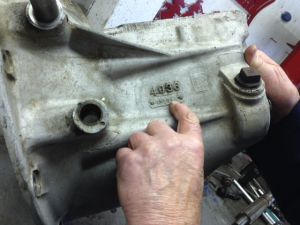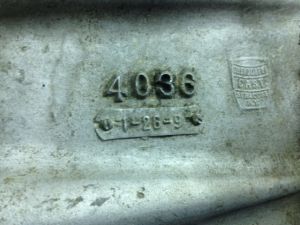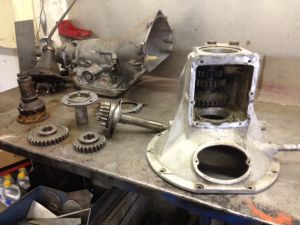- Home
- About Us
- Join/Renew
- Member Benefits
- Member Pages
- Log In
- Help
- Museum Store
Message deleted by original poster
1

1

1

The casting date of the transmission is still in tact. 1/26/29. Depending on when they actually started produciton of the 29’s it was a super early car. Or, at least my transmisison is early.
Does anyone know how long it took to produce a single car?
After total disasembly and inspection. It was found that the front main bearing was going bad. The rear seemed fine but since it was all apart both were replaced.
The mechanic indicated that it was in such fantastic shape, the gears looked in better shape than the new tranmissions of today. 
Based on the wear, or lack there of, everyone believes this Phaeton is a true 65k car. Way cool!

Is the serial number of your car very early as well?
Good to see that the car appears to be a true low mileage survivor.
Richard,
I had to take my transmission apart a few years ago. At the time, I didn’t know or see that the gears are timed. Guess what, as a result I grind gears more than I should in a Pierce Arrow. One of my winter projects is to remove the transmission and see if I can locate the timing marks on the gears. I am a bit nervous that the marks are real faint in my car since I didn’t see them the first time. Hopefully, the second time is the charm for me.
I assume your 29 is timed as well, make certain your mechanic is aware of this.
John,
Thanks, I will let him know. Rick
John if you have a 4 speed tranny, then timing is esential and you could break teeth if not timed properly. Most 1931 cars had a 3 speed, free -wheeling unit, and I don’t know if it required timing or not.
The 1930 and some 1931 cars had syncronized gears on third and forth, and you could shift between them without pushing the clutch down. Most owners don’t know that it was a major selling point for 1930, and was also a very quiet unit. Many LeBaron models for 1931 have this tranny.
First and Foremost:
Can anybody definitively tell me if the 3 speed transmission in a 1929 was timed? I am trying to clarify this point for Rick and his mechanic.
Concerning my car:
I know that my 1931 3-speed with free-wheeling is timed after seeing the timing marks in a friends 1931 3-speed. I assume that this was a necessity to allow the car to better shift from free-wheeling second to high without the clutch and also transition from either free-wheeling gear (second or high) into the “work on compression / hard” second or high gear. Guys, am I correct?
A 1929 transmission is not timed. The ’29 transmission is much like the Series 80 and 81 transmissions: all the gears are straight-cut, and only third or direct gear is quiet. 1st and 2nd gears make a lot of noise because of the straight cut gears.
The later transmissions had different designed gear teeth, some were beveled , or cut on an angle. This makes for quiet gears.
Some of the ’30 and later transmissions have a very odd ‘Herringbone’ cut, two piece gear. Each gear has two halves, and the two are riveted together. This trans DOES have timing marks.
I THINK this is the Clark 4 speed transmission, with the ‘Silent Second’ gear. This trans is described as having Low gear, 1st gear, Silent Second Gear, and 3rd Gear or Direct.
Low gear is found by pulling the shift lever hard to the left, against a fairly stiff spring, then back toward the driver. This gear is good for pulling stumps, and idling along in parades. It is rarely used in regular driving.
The reason for the ‘Herringbone’ cut gears is to eliminate the for and aft thrust that a helical or slant-cut gear has. With acceleration, the gear is forced one way, on deceleration, it is forced the opposite direction. If the ball bearings that locate the gear and shafts in the transmission wear enough, you end up with a trans that ‘jumps out of gear’ when the right load is applied.
With a Herringbone cut gear, the two angle-cut gears oppose each other with no end thrust as the result.
I hope the above information on the ’30 and later transmissions is correct, if anyone knows that what I wrote is erroneous info please correct me.
Greg Long
A bit more to Greg’s note. The two halves have teeth that are spaced slightly differently so that as the gears rotate ther is always two teeth in constant contact. When the the change from 3rd to 4th is made it is not by sliding one gear into contact with another. These gears are permanently meshed, and the change is made by sliding the drive shaft from the center of one set of gears to the other, which is why you can shift with out touching the clutch. Best trans mission made in those days. Expensive and tricky. You will read in the past PAS notes how many guys have thrown these tranys away and replaced them with a standard box. They didn’t know what a marvelous box they had, and could not figure out how to repair them.The gears have timing marks and must be lined up correctly.
Could a late Series 81, specifically serial #8109124, have come with a herringbone transmission. I’m asking because my father and his brothers rebuilt that car after the war, and he always wanted me to get a Series 81 because of the great engine AND transmission. Dad definitely described the gears and free-wheeling to me as a wee lad and I’m pretty sure that was the only Pierce he ever got a chance to tear apart.
As an aside, if anyone knows the location of 8109124, a 7 passenger sedan, I would really like to know.
The herringbone type gears were “invented” by Andre Citroen, hence the Citroen icon still used today. I wonder if Pierce Arrow had to bought a licence for the design?
A series 81 transmission is identical to a Series 80 transmission. And a 1929 transmission internally looks very much the same: straight cut gears, no beveled gears or Herringbone gears.
As far as I know the Herringbone gear transmission did not get used in Pierces until 1930 in the model A and B cars. The Model C 1930 cars still had the ’29 transmission, straight cut gears and a driveshaft drum parking brake.
The ’29 transmission had the parking brake on a drum on the output hub of the transmission, an external contracting band was the parking brake. The Series 80 and 81 parking brake was by actuating the rear drum brakes via the brake handle.
Greg Long
